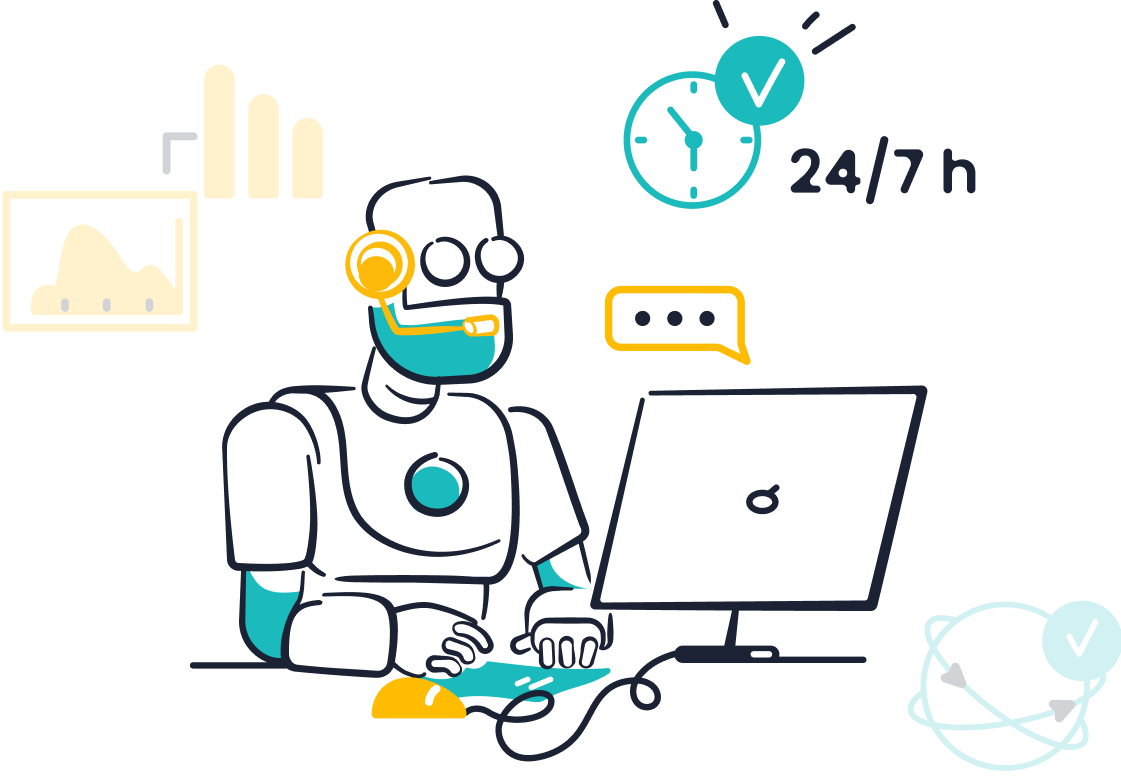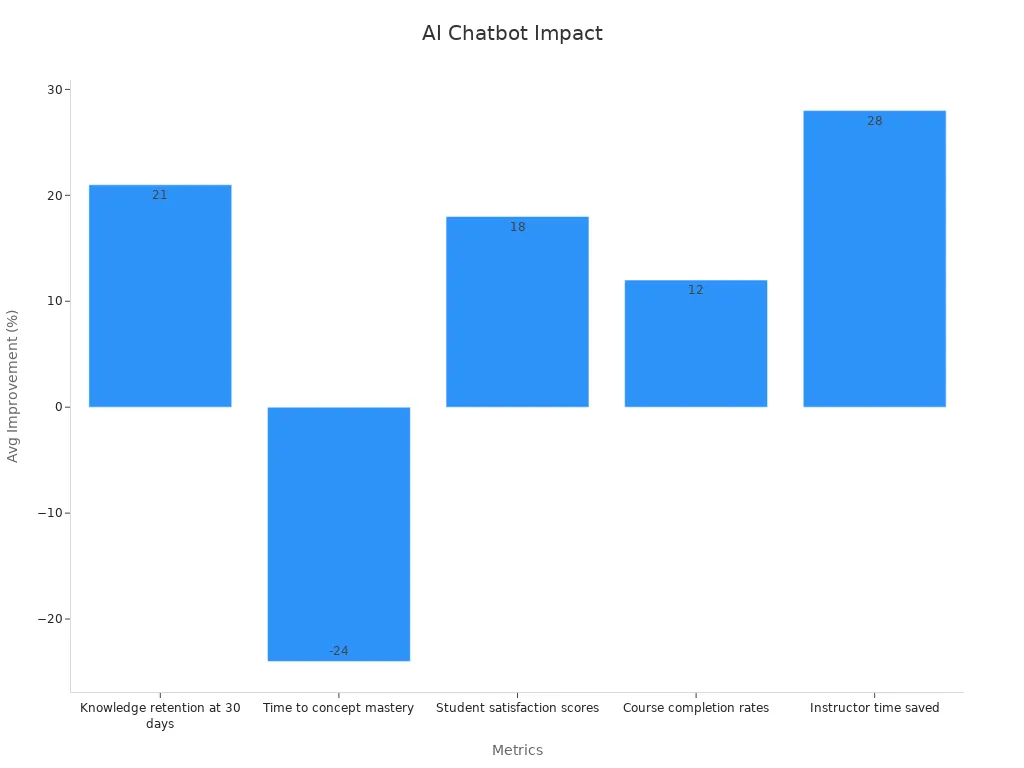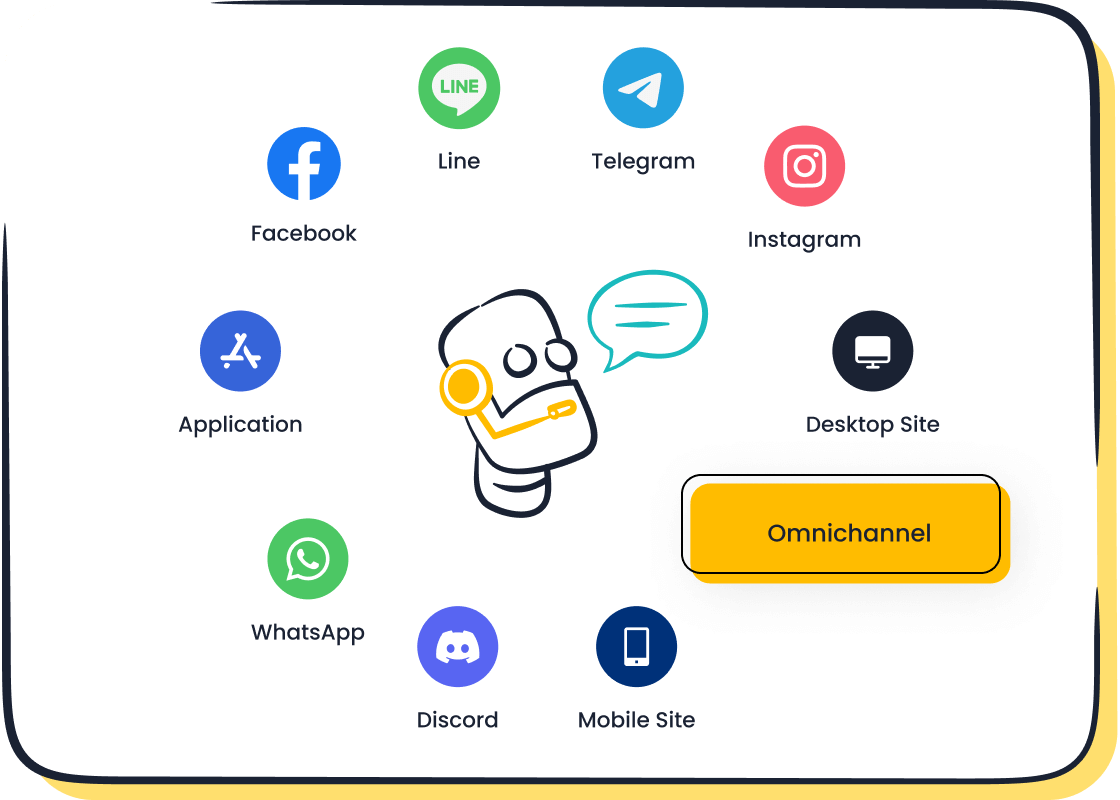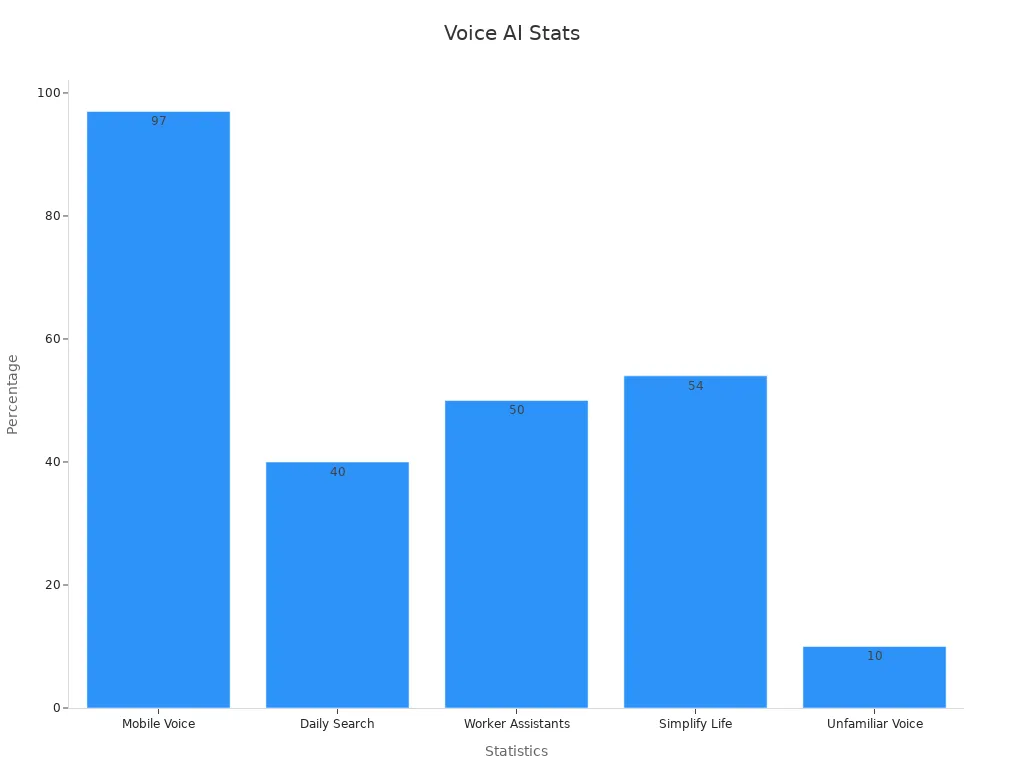How AI Chatbots Are Transforming Technology in 2025

AI chatbots are reshaping how businesses operate and interact with customers in 2025. These intelligent tools streamline service processes, offering faster responses and personalized solutions. For instance, chatbots now handle 95% of customer service interactions, significantly reducing workloads for human agents. Retail consumers spent over $142 billion via chatbots last year, showcasing their impact on sales and operational efficiency.

Sobot’s AI chatbot stands out as the best chatbot solution for modern businesses. It automates routine tasks, assists agents, and enhances customer interactions across multiple platforms. Whether you're in retail, finance, or healthcare, this solution ensures seamless service delivery while improving customer experience and reducing costs.
The Evolution of AI Chatbots

From Rule-Based Systems to Conversational AI
AI chatbots have come a long way since their early days. Initially, chatbots relied on rule-based systems. These systems followed pre-programmed scripts and could only respond to specific commands. While they were useful for basic tasks, they lacked the ability to understand context or hold meaningful conversations.
Today, conversational AI has replaced these rigid systems. Modern chatbots use advanced technologies like natural language processing (NLP) to understand and respond to user queries more effectively. They can interpret context, detect intent, and even adapt their responses based on past interactions. This shift has made chatbots more human-like, allowing them to handle complex conversations and provide personalized experiences.
The Role of Machine Learning in Chatbot Development
Machine learning plays a crucial role in the development of AI chatbots. It enables chatbots to learn from data and improve over time. For example, when you interact with a chatbot, it analyzes your input and uses that information to refine its responses. This continuous learning process helps chatbots become smarter and more efficient.
The rise of GPT-3 marked a significant milestone in chatbot technology. This transformer model introduced the ability to generate human-like text, making conversations more natural. As a result, chatbots can now handle tasks like customer support, e-commerce assistance, and even emotional support with greater accuracy. Machine learning has also paved the way for the latest advancements, such as multimodal AI, which combines text, voice, and images for seamless interactions.
Key Milestones Leading to 2025
Several breakthroughs have shaped the evolution of AI chatbots. In 2020, Google introduced Meena, a chatbot capable of discussing various topics coherently. Around the same time, Facebook AI launched BlenderBot, designed for empathetic conversations. The rise of GPT-3 further revolutionized the field by enabling chatbots to understand context and generate meaningful responses.
Looking ahead, the latest chatbot trends focus on personalization and emotional intelligence. By 2025, chatbots are expected to deepen their emotional connections with users and integrate multimodal interactions. These advancements will allow chatbots to handle more complex tasks, making them indispensable across industries like healthcare, finance, and retail.
Advancements in Conversational AI Technologies
Natural Language Processing (NLP) in 2025
Natural Language Processing (NLP) has become the backbone of modern AI chatbots. By 2025, advancements in natural language processing have enabled chatbots to understand and respond to user queries with remarkable accuracy. These improvements allow chatbots to recognize intent, extract key information, and manage context in multi-turn conversations. For example, when you ask a chatbot about a product, it can remember your preferences and provide tailored recommendations during the same interaction.
Modern NLP frameworks like spaCy and Google’s Dialogflow have introduced pre-built models that businesses can customize to train their chatbots. These models enhance NLP capabilities, such as sentiment analysis and state tracking, making conversational engagement more natural. By combining NLP with machine learning, AI-powered chatbots can now handle complex requests and adapt their responses based on past interactions. This hybrid approach ensures that chatbots deliver more personalized and contextually appropriate solutions.
In the healthcare sector, conversational AI has already assisted in treating over 3 million patients. This demonstrates how NLP advancements are not only improving chatbot adaptability but also transforming industries like healthcare, where accurate and empathetic communication is critical.
Multimodal AI for Seamless Interactions
Multimodal AI is revolutionizing how you interact with chatbots by integrating text, voice, and even images into a single conversation. By 2025, 50% of buyers prefer multimodal interactions as their primary communication format. This shift highlights the growing demand for seamless and intuitive user experiences.
Imagine asking a chatbot about a product while uploading an image for reference. The chatbot can analyze the image, understand your query, and provide relevant suggestions. This capability enhances user engagement by making interactions more dynamic and personalized. In smart environments, multimodal AI is being used for disaster prevention and resource management, showcasing its practical applications beyond customer service.
Voice compatibility is another key aspect of multimodal AI. With 75% of customers expressing a preference for voice-enabled chatbots, businesses are increasingly adopting voice assistants. In fact, 82% of companies now utilize voice assistants to meet customer expectations. This trend underscores the importance of integrating voice capabilities into AI-powered chatbots to ensure they remain relevant and effective.
Emotional Intelligence and Affective AI
Emotional intelligence is the next frontier for AI chatbots. By 2025, advancements in affective AI are enabling chatbots to recognize and respond to emotional cues, creating more meaningful interactions. For instance, when you express frustration during a conversation, the chatbot can detect your tone and adjust its responses to provide reassurance or escalate the issue to a human agent.
Studies have shown that emotional engagement with chatbots can significantly impact user satisfaction. However, the effects vary based on factors like conversation type and duration. For example, personal conversations with chatbots may lead to higher loneliness but lower emotional dependence. These findings highlight the need for balanced emotional intelligence in AI-powered chatbots to ensure positive outcomes.
In healthcare, affective AI is improving communication between patients and providers. Chatbots equipped with emotional intelligence can offer empathetic support, making patients feel heard and understood. This capability is particularly valuable in scenarios where human interaction may not be immediately available.
Study Title | Key Findings |
|---|---|
Early methods for studying affective use and emotional wellbeing in ChatGPT | Emotional engagement with ChatGPT is rare in real-world usage. Affective cues were absent in most conversations. |
How AI and Human Behaviors Shape Psychosocial Effects of Chatbot Use | Voice modes had mixed effects on wellbeing. Brief use led to better outcomes, while prolonged use showed negative effects. |
As emotional intelligence continues to evolve, chatbots will play a crucial role in fostering deeper connections with users, enhancing both customer satisfaction and operational efficiency.
Generative AI and Large Language Models
Generative AI has revolutionized the way chatbots interact with users. By 2025, these advanced systems have become the backbone of conversational AI, enabling chatbots to generate human-like responses. Unlike traditional methods, generative AI uses large language models to understand context, predict user intent, and craft meaningful replies. These models rely on vast datasets and advanced algorithms to simulate natural conversations, making interactions more engaging and effective.
Large language models, such as GPT-4, have set new standards in chatbot performance. They process billions of parameters, allowing them to understand complex queries and provide accurate answers. To handle the complexities of using various large language models, many organizations use an AI workspace for multiple LLMs as a centralized hub. For example, when you ask a chatbot about a product, it can analyze your question, consider your preferences, and offer tailored recommendations. This capability enhances user satisfaction and builds trust in AI-powered systems.
How Generative AI Improves Chatbot Performance
Generative AI enhances chatbot functionality in several ways:
It enables chatbots to handle diverse topics, from customer support to e-commerce assistance.
It improves response accuracy by learning from user interactions.
It supports multilingual communication, breaking language barriers for global users.
Performance metrics play a crucial role in evaluating these advancements. Benchmarks like SuperGLUE and MMLU assess the accuracy of question-answering tasks, while BLEU scores measure translation quality. Emerging benchmarks, such as BIG-bench and HELLASWAG, test a model's logic and creativity. These tools ensure that chatbots powered by generative AI meet high standards of reliability and effectiveness.
The Role of Benchmarks in Measuring Success
To understand how well a chatbot performs, you need reliable benchmarks. The E2E benchmark evaluates the usefulness of chatbot responses, particularly for those using large language models. Cosine similarity measures how closely a chatbot's reply matches the expected answer. Search stability and relevance metrics assess consistency and the quality of search results. These benchmarks ensure that chatbots deliver consistent and meaningful interactions.
For instance, search relevance uses metrics like Normalized Discounted Cumulative Gain (NDCG) to rank the quality of responses. This ensures that when you interact with a chatbot, the information provided is both accurate and helpful. These evaluations highlight the importance of continuous improvement in generative AI and large language models.
Real-World Applications of Generative AI
Generative AI has transformed industries by making chatbots more versatile. In retail, chatbots assist customers by providing personalized product suggestions. In healthcare, they offer empathetic support and accurate information to patients. Financial services use chatbots to detect fraud and guide users through complex processes. These applications demonstrate the wide-ranging impact of generative AI on modern business operations.
By integrating generative AI, chatbots can also handle multimodal interactions. This means they can process text, voice, and images simultaneously, creating seamless user experiences. For example, you can upload an image of a product, and the chatbot will analyze it to provide relevant details. This capability makes interactions more dynamic and user-friendly.
Generative AI and large language models have redefined what chatbots can achieve. They enable smarter, more intuitive interactions, ensuring that businesses meet the evolving needs of their customers. As these technologies continue to advance, you can expect chatbots to become even more indispensable in everyday life.
Applications of AI Chatbots Across Industries
Enhancing Customer Service in Retail and E-Commerce
AI chatbots have revolutionized customer service in retail and e-commerce. They provide faster responses, reduce costs, and improve customer satisfaction. You no longer need to wait for a human agent to resolve your queries. AI-powered chatbots handle up to 90% of consumer inquiries, ensuring efficiency and accuracy.
Retailers use chatbots to offer personalized support, such as product recommendations based on your preferences. These chatbots also assist in reducing cart abandonment by sending proactive reminders or offering discounts. For example, when you leave items in your cart, the chatbot can send a message encouraging you to complete the purchase.
Here are some key benefits of chatbot use cases in retail and e-commerce:
61% of customers prefer faster AI responses over waiting for human agents.
Chatbots reduce customer support costs by up to 80%.
Ticket resolution time decreases from 38 hours to just 5.4 minutes.
By 2027, the global chatbot market is expected to reach $455 million.
Business leaders report that chatbots boost sales by an average of 67%.
Sobot’s AI chatbot exemplifies how chatbot integration can transform customer engagement. It operates 24/7, providing seamless customer interactions across multiple platforms. This ensures that your shopping experience remains smooth and efficient, even during peak times.
AI Chatbots in Healthcare for Patient Support
AI-powered assistants are making healthcare more accessible and efficient. Chatbots in this sector provide accurate information, empathetic communication, and real-time support. For instance, when you have a health-related question, the chatbot can offer reliable advice or connect you with a healthcare professional.
A study in the British Medical Journal highlighted the effectiveness of AI in healthcare. It compared Ada, an AI chatbot, with human doctors in 200 clinical scenarios. Ada recognized 99% of conditions, while human doctors achieved 100%. Together, they provided safe advice 97% of the time. This demonstrates the potential of AI solutions in delivering trustworthy healthcare support.
Metric Category | Description |
|---|---|
Accuracy | Measures the precision of chatbot responses in healthcare scenarios. |
Trustworthiness | Evaluates the reliability of the chatbot in providing health information. |
Empathy | Assesses the chatbot's ability to understand and respond to patient emotions. |
Computing Performance | Analyzes the efficiency and speed of the chatbot in delivering responses. |
AI chatbots also enhance patient engagement, especially among older adults. Users over 60 report low cognitive load, indicating that these systems are easy to use. Some healthcare chatbots achieve over 90% engagement rates and 97% adherence rates in care plans. This shows how AI-powered chatbots improve both accessibility and patient outcomes.
Sobot’s chatbot offers personalized support in healthcare by integrating advanced NLP and emotional intelligence. It ensures that patients receive accurate and empathetic responses, making healthcare more patient-centric.
Financial Services and Fraud Prevention
AI chatbots play a critical role in financial services by improving fraud detection and customer support. These systems analyze vast amounts of data to identify patterns and anomalies that may indicate fraudulent activities. For example, when a suspicious transaction occurs, the chatbot can flag it and alert you immediately.
AI chatbots offer 24/7 monitoring and support to flag and temporarily block suspicious activities, alerting the user to verify the transactions.
Financial institutions benefit from AI-powered chatbots by reducing false positives and improving fraud detection rates. Wells Fargo implemented an AI-based fraud detection system that uses deep learning algorithms to scrutinize real-time transaction patterns. This significantly improved fraud detection accuracy.
Financial institutions that implemented AI for fraud detection reported a 50% reduction in false positives and a 60% improvement in fraud detection rates.
Sobot’s AI chatbot enhances financial services by providing secure and efficient solutions. It ensures robust protection for both institutions and customers, reducing detection time from days to mere seconds. This makes financial transactions safer and more reliable for you.
AI Chatbots in Call Centers and Customer Support
AI chatbots have transformed call centers and customer support by improving efficiency and enhancing user experiences. These systems handle repetitive queries, allowing human agents to focus on complex issues. You no longer need to wait on hold for long periods. Instead, chatbots provide instant responses, ensuring faster resolutions and higher satisfaction.
Call centers benefit from AI chatbots in several ways:
They reduce operational costs by automating routine tasks.
They improve response times, ensuring customers receive help quickly.
They enhance accuracy by providing consistent and reliable information.
Metrics highlight the impact of AI chatbots in this sector:
Metric | Description |
|---|---|
Average Response Time | Measures the time taken to respond to customer inquiries. |
Resolution Rate | Indicates the percentage of issues resolved on the first contact. |
Customer Feedback Scores | Reflects customer satisfaction and experience with the service provided. |
For example, when you contact a support center, the chatbot can guide you through troubleshooting steps or provide updates on your request. This reduces the workload for agents and ensures you receive timely assistance.
Sobot’s AI chatbot exemplifies these benefits. It operates 24/7, handling inquiries across multiple channels like voice, email, and chat. This omnichannel approach ensures seamless interactions, even during peak times. By integrating advanced technologies like natural language processing, Sobot’s chatbot delivers accurate and personalized solutions, making your experience smoother and more efficient.
Education and E-Learning Assistance
AI chatbots are revolutionizing education and e-learning by making learning more accessible and engaging. These systems provide personalized support, helping you master concepts faster and retain knowledge longer. Whether you’re a student or a professional, chatbots enhance your learning experience by offering instant feedback and tailored resources.
Research shows the significant impact of AI chatbots in education:
Metric | Average Improvement |
|---|---|
Knowledge retention at 30 days | +21% |
Time to concept mastery | -24% |
Student satisfaction scores | +18% |
Course completion rates | +12% |
Instructor time saved | +28% |

Chatbots in e-learning platforms provide several advantages:
They offer 24/7 availability, ensuring you can access help anytime.
They use gamification elements like badges and progress tracking to keep you motivated.
They break down complex topics into manageable steps, making learning less overwhelming.
For instance, Georgia State University saved $5 million in administrative costs while improving student outcomes through chatbot implementation. Similarly, Arizona State University reduced support costs by 32% and increased satisfaction ratings. Corporate e-learning programs also reported faster training completion and better knowledge application.
Chatbots employ psychological frameworks to enhance motivation. They use gamification, social learning principles, and goal-setting techniques to keep you engaged. These strategies create a sense of achievement and accountability, making learning more enjoyable.
Sobot’s chatbot supports education by providing real-time assistance and personalized learning paths. It integrates seamlessly with e-learning platforms, ensuring you receive accurate and timely support. Whether you’re preparing for exams or completing professional training, Sobot’s chatbot helps you stay on track and achieve your goals.
Benefits of AI Chatbots for Businesses
Cost Efficiency and Scalability
AI chatbots provide businesses with significant cost savings and scalability. By automating repetitive tasks, chatbots reduce the need for additional staff, saving industries up to $11 billion annually. They handle multiple inquiries simultaneously, ensuring operational efficiency without increasing costs. For example, during high-volume campaigns, chatbots maintain service levels while managing thousands of interactions at once.
Evidence Type | Details |
|---|---|
Cost Savings | Chatbots save over $11 billion in transaction costs by automating customer interactions. |
Operational Efficiency | They reduce the need for extra staff by managing high inquiry volumes effectively. |
Scalability | Businesses can scale operations without incurring additional infrastructure expenses. |
This scalability is especially beneficial for growing businesses. You can expand your services without worrying about hiring more agents or increasing operational costs.
Hyper-Personalization for Customer Engagement
AI chatbots excel in delivering hyper-personalized experiences, enhancing customer engagement. They analyze vast amounts of data to understand user preferences and predict behavior. This allows businesses to offer tailored recommendations and timely offers. For instance, chatbots use real-time data to provide personalized responses, making interactions more relevant and engaging.
AI processes data quickly, identifying patterns to improve user experience.
Predictive analytics help businesses anticipate customer needs.
Chatbots create micro-segments for targeted marketing campaigns.
Dynamic content keeps users interested by catering to individual preferences.
This ai-driven personalization ensures that every interaction feels unique, fostering stronger connections with customers.
24/7 Availability and Faster Response Times
AI chatbots operate around the clock, ensuring you receive instant support whenever needed. Unlike human agents, chatbots don’t require breaks, making them available 24/7. This eliminates delays and allows users to resolve issues immediately, whether it’s a simple query or a complex problem.
Chatbots provide instant responses, improving user experience.
Service Level Agreements ensure consistent uptime and fast resolutions.
Businesses meet customer expectations by offering uninterrupted support.
This constant availability enhances satisfaction and builds trust, as users know they can rely on chatbots for immediate assistance.
Data-Driven Insights for Business Growth
AI chatbots are transforming how businesses use data to grow and succeed. These intelligent systems analyze vast amounts of information and provide actionable insights that help you make smarter decisions. By using chatbots, you can monitor operations, track performance, and identify opportunities for improvement—all in real time.
One of the most valuable features of AI chatbots is their ability to deliver instant alerts and reports. You no longer need to rely on complex business intelligence systems to stay informed. For example:
Chatbots notify you about inventory changes, ensuring you can manage stock levels efficiently.
They send performance updates directly to decision-makers, helping you respond quickly to market trends.
These insights allow you to act faster and stay ahead of competitors.
Businesses that adopt AI chatbots often see measurable results. A unified data strategy helped one company increase revenue by 15% while cutting development costs by 20%. Personalized promotions powered by chatbot analytics boosted conversion rates by 8%, generating $9 million in additional sales. Call center automation reduced query resolution time by 65%, saving $12 million in operating costs. These examples highlight how data-driven decisions can lead to significant growth.
AI chatbots also enhance customer engagement. They analyze user behavior to create personalized experiences, which improve satisfaction and loyalty. A recent webinar revealed how AI-powered web analytics enable businesses to tailor their services, ensuring every interaction feels relevant and meaningful.
By leveraging the insights provided by AI chatbots, you can optimize operations, improve customer experiences, and drive sustainable growth. These tools empower you to make data-backed decisions that lead to long-term success.
Challenges and Ethical Considerations in AI Chatbot Adoption
Data Privacy and Security Concerns
When you use AI chatbots, your data privacy and security become critical concerns. Many users worry about how their personal information is collected, stored, and used. A study by PwC revealed that 40% of voice assistant users feel uneasy about their voice data. Similarly, 68% of global consumers express concerns about online privacy. These statistics highlight the growing need for secure systems.
Businesses adopting chatbots must address these issues. For instance, companies should implement encryption and comply with data protection regulations like GDPR. However, challenges persist. A YouGov survey found that 60-70% of U.K. adults believe smart devices listen to conversations without consent. This perception can erode trust in AI systems.
To ensure safe customer interactions, you should look for chatbots that prioritize security. Sobot’s AI chatbot, for example, uses advanced encryption and continuous backups to protect user data. These measures help build confidence in AI-powered solutions.
Transparency and Trust in AI Interactions
Trust plays a vital role in your experience with AI chatbots. Transparency is key to building this trust. When chatbots clearly explain how they work and where their data comes from, you feel more confident using them. Research shows that organizations struggle to document model training data and biases. This lack of clarity can create doubts about the chatbot’s reliability.
Explainable AI (XAI) principles can address these challenges. By providing clear documentation and engaging stakeholders, businesses can improve transparency. For example, a study on AI in emergency management emphasized the importance of explaining data sources and methodologies. These practices ensure accountability and foster trust.
Sobot’s chatbot exemplifies transparency by offering detailed reporting and optimization tools. These features allow businesses to monitor performance and address any issues, ensuring a trustworthy user experience.
Addressing Bias in AI Algorithms
Bias in AI algorithms can affect the fairness of chatbot interactions. For example, biased datasets can lead to inaccurate responses or unfair treatment. Academic research highlights the importance of addressing this issue. Studies suggest using diverse data sources and conducting regular audits to reduce bias.
One effective method involves reconfiguring unbalanced datasets. Oversampling techniques can help identify and correct biases. Additionally, integrating small and big data enhances accuracy. A chart summarizing research on bias in AI algorithms illustrates these strategies:
Sobot’s AI chatbot addresses bias by using multilingual support and customizable workflows. These features ensure fair and accurate customer interactions, regardless of language or cultural differences.
Balancing Automation with Human Touch
Automation has transformed customer service, but human interaction remains essential for creating meaningful connections. While AI chatbots handle repetitive tasks efficiently, you still need human agents to address complex or sensitive issues. Striking the right balance between automation and the human touch ensures both efficiency and customer satisfaction.
AI excels at managing routine inquiries. For example, a major retail chain implemented chatbots to handle common questions, reducing response times by 25%. This allowed human agents to focus on more intricate problems, improving overall customer satisfaction. Similarly, Lyft uses AI models to automate simple tasks, ensuring that human agents can dedicate their time to resolving complicated concerns. These examples show how automation can enhance productivity without compromising service quality.
However, human agents play a crucial role in interpreting emotional cues and building rapport. Many customers prefer speaking with a person when dealing with sensitive matters. In healthcare, for instance, AI assists with scheduling and reminders, reducing administrative burdens. Yet, human interaction remains vital for patient care, especially when empathy and understanding are required.
To achieve this balance, you should integrate AI solutions like Sobot’s chatbot into your operations. These tools handle repetitive tasks, freeing your team to focus on high-value interactions. By combining automation with human expertise, you can deliver faster responses while maintaining a personal touch. This approach not only improves efficiency but also strengthens customer trust and loyalty.
Balancing automation with human interaction ensures that your business meets customer expectations. While AI enhances efficiency, the human touch adds empathy and understanding, creating a service experience that feels both seamless and personal.
The Future of Chatbots: Trends and Predictions

Hyper-Personalization and Context-Aware Chatbots
The future of chatbots lies in their ability to deliver hyper-personalized and context-aware interactions. These intelligent systems analyze your preferences, past interactions, and real-time data to provide tailored responses. For example, when you shop online, a chatbot can recommend products based on your browsing history and current needs. This level of personalization makes your experience more engaging and efficient.
Studies show that 91% of consumers prefer brands that recognize and remember their preferences. By 2027, advancements in natural language processing and machine learning will make chatbots the primary customer service channel for 25% of organizations. Personalization will evolve from general demographic-based experiences to highly specific interactions that consider your unique search intent and context.
Autonomous AI Agents for Complex Tasks
Autonomous AI agents are transforming how businesses handle complex tasks. These intelligent digital agents operate independently, planning and executing actions without constant supervision. They analyze data, adapt to changing environments, and collaborate with other systems to achieve goals.
For instance, in healthcare, AI agents improve patient engagement by providing personalized care plans. In customer service, they automate interactions, reducing costs and improving efficiency. Market research predicts significant growth in multi-agent systems, which enhance collaboration and problem-solving across industries. These systems use advanced technologies like deep learning and multimodal data processing to deliver superior results.
Segment | Market Share (2024) | Growth Rate (CAGR) | Key Insights |
|---|---|---|---|
Machine Learning | 30.5% | Highest | Enables AI agents to analyze data and make decisions quickly, enhancing operational efficiency. |
Multi-Agent Systems | N/A | Highest | Enhances collaboration and problem-solving capabilities across industries. |
Customer Service & Virtual Assistants | Largest | N/A | Automates customer interactions, improving efficiency and reducing costs. |
These predictions highlight the growing role of autonomous AI agents in shaping the future of chatbots.
Integration with IoT and Smart Devices
AI chatbots are becoming integral to the Internet of Things (IoT) ecosystem. They connect with smart devices to create seamless and intuitive user experiences. Imagine controlling your home appliances through a chatbot. You could adjust your thermostat, turn off lights, or even check your refrigerator’s inventory—all through a single conversation.
This integration enhances convenience and efficiency. Businesses are adopting AI-powered systems to manage IoT devices, ensuring smooth operations. For example, chatbots in smart factories monitor equipment performance and predict maintenance needs. These applications demonstrate how AI chatbots and IoT work together to optimize workflows and improve productivity.
As IoT adoption grows, chatbots will play a crucial role in managing connected devices. They will act as the bridge between you and your smart environment, making everyday tasks easier and more efficient.
The Rise of Voice-First AI Interfaces
Voice-first AI interfaces are transforming how you interact with technology. These systems allow you to control devices, search for information, and complete tasks using only your voice. By 2025, voice-first interfaces are expected to dominate customer interactions, making them a key part of modern technology trends.
The adoption of voice assistants has grown rapidly. Today, 97% of mobile users rely on voice assistants for daily tasks. Over 4 billion devices already feature AI voice assistants, and this number is expected to double by the end of 2023. Voice search now accounts for 40% of daily internet usage, showing how essential this technology has become. By 2025, half of all knowledge workers will use virtual assistants to simplify their work. These statistics highlight the growing importance of voice-first AI interfaces in your daily life.
Statistic | Value |
|---|---|
Percentage of mobile users using voice assistants | 97% |
Number of devices with AI voice assistants | Over 4 billion |
Expected number of devices by end of 2023 | 8 billion |
Daily usage of voice search | 40% |
Anticipated percentage of knowledge workers using virtual assistants by 2025 | 50% |
Percentage of users finding virtual assistants simplify their lives | 54% |
Percentage of population unfamiliar with voice-enabled products | 10% |

Voice-first AI interfaces also enhance customer experiences. For example, when you interact with a chatbot, voice capabilities make the conversation feel more natural. Businesses are leveraging this technology to improve accessibility and engagement. As part of ai chatbot trends, voice-first systems are becoming integral to industries like retail, healthcare, and education. These interfaces simplify tasks, save time, and make technology more intuitive for you.
The rise of voice-first AI interfaces reflects a shift toward more seamless and user-friendly interactions. As this technology continues to evolve, it will redefine how you engage with digital systems, making your experiences faster and more efficient.
AI chatbots have transformed how businesses operate in 2025. Their widespread adoption has improved efficiency, reduced costs, and enhanced customer engagement. These tools now play a vital role in industries like retail, healthcare, and finance. By automating tasks and delivering personalized interactions, they have redefined customer service. However, their integration also highlights the importance of addressing ethical and regulatory challenges.
To stay competitive, you must embrace these advancements. AI chatbots not only streamline operations but also help meet evolving customer expectations. Their potential to revolutionize technology makes them an essential tool for modern businesses.
FAQ
What is the primary purpose of AI chatbots?
AI chatbots automate customer interactions. They handle repetitive queries, provide instant responses, and assist human agents. This improves efficiency, reduces costs, and enhances customer satisfaction.
Can AI chatbots operate across multiple platforms?
Yes, AI chatbots like Sobot’s solution offer omnichannel support. They interact seamlessly on platforms like WhatsApp, email, and SMS. This ensures consistent communication across all customer-preferred channels.
How do AI chatbots ensure data security?
AI chatbots use encryption, GDPR compliance, and continuous backups to protect user data. These measures ensure your information remains secure during interactions.
Do AI chatbots require coding knowledge to set up?
No, most modern chatbots, including Sobot’s, feature no-code interfaces. You can design workflows using point-and-click tools, making setup simple and accessible.
How do AI chatbots improve customer engagement?
AI chatbots analyze user behavior to deliver personalized experiences. They offer tailored recommendations, proactive messaging, and real-time assistance. This creates meaningful interactions and boosts customer satisfaction.
See Also
10 Leading Websites Utilizing Chatbots This Year
10 Most Effective Chatbots for Websites in 2024
Simple Ways to Integrate Chatbot Examples on Websites
